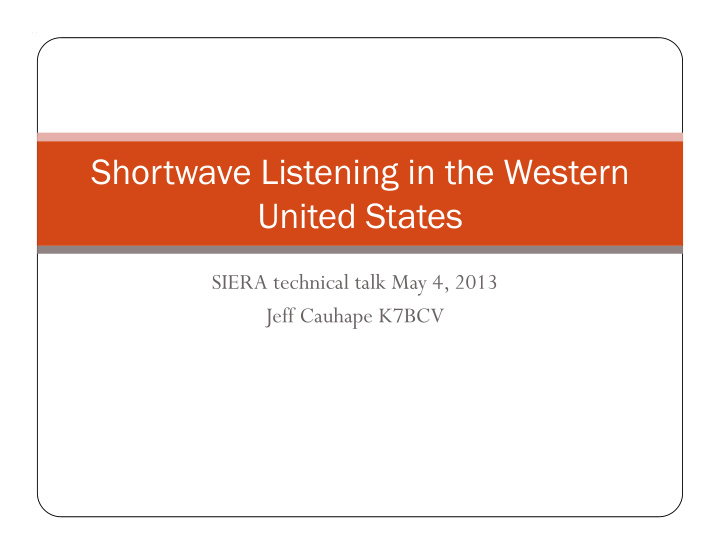



Shortwave Listening in the Western United States SIERA technical talk May 4, 2013 Jeff Cauhape K7BCV
Understanding the SW Bands – Pt 1 Band Name Frequencies Daytime Nighttime Notes 2 Mhz (120 m) 2300-2495 kHz Local only Rare Used by very few domestic stations 3 MHz (90 m) 3200-3400 kHz Local only Limited Mostly domestic audience 4 MHz (75 m) 3900-4050 kHz Good to fair Good to fair Both domestic and international, but not beamed to Americas 5 MHz (60 m) 4750-4995 kHz Regional Fair Mostly domestic 6 MHz (49 m) 5730-6300 kHz Regional Excellent 7 MHz (41 m) 6890-7600 kHz Regional Good Few target the US 9 MHz (31 m) 9250-9995 kHz Fair Good Daytime is fair in Winter, only fair in summer. Night good in summer.
Understanding the SW Bands – Pt 2 Band Name Frequencies Daytime Nighttime Note 11 MHz (25 m) 11500-12200 kHz Good Variable 13 MHz (22 m) 13570-13870 kHz Good Variable 15 MHz (19 m) 15005-15825 kHz Good Variable 17 MHz (16 m) 17480-17900 kHz Good Limited in Summer 19 MHz (15 m) 18900-19020 kHz Good Limited in Summer 21 MHz (13 m) 21450-21850 kHz Limited Rare 25 MHz (11 m) 25670-26100 kHz Rare None
Optimal SW Band (MHz) for Listening in the Western US January, February and November, December local UTC Eur E NA W NA C/S C/S Af ME/S. E. Asia Aus / Am As NZ 00:00 – 04:00 08:00 – 12:00 9 7 7 9 n/a 15 9 11 04:00 – 08:00 12:00 – 16:00 13 11 7 21 n/a 11 9 9 08:00 – 12:00 16:00 – 20:00 15 17 13 21 25 13 9 15 12:00 – 16:00 20:00 – 00:00 9 15 13 17 21 13 13 17 16:00 – 20:00 00:00 – 04:00 9 9 9 9 13 17 17 21 20:00 – 00:00 04:00 – 08:00 6 7 7 7 9 17 11 15
Optimal SW Band (MHz) for Listening in the Western US March, April and September, October local UTC Eur E NA W NA C/S C/S Af ME/S. E. Asia Aus / Am As NZ 00:00 – 04:00 08:00 – 12:00 9 7 7 11 n/a 17 9 11 04:00 – 08:00 12:00 – 16:00 17 15 7 21 21 13 11 13 08:00 – 12:00 16:00 – 20:00 17 17 15 25 21 17 13 17 12:00 – 16:00 20:00 – 00:00 15 15 13 21 21 15 17 25 16:00 – 20:00 00:00 – 04:00 11 11 9 11 15 17 17 25 20:00 – 00:00 04:00 – 08:00 9 9 7 13 11 n/a 13 15
Optimal SW Band (MHz) for Listening in the Western US May through August local UTC Eur E NA W NA C/S C/S Af ME/S. E. Asia Aus / Am As NZ 00:00 – 04:00 08:00 – 12:00 11 7 7 13 n/a 17 13 11 04:00 – 08:00 12:00 – 16:00 15 15 11 17 21 15 15 13 08:00 – 12:00 16:00 – 20:00 17 13 13 21 21 21 15 n/a 12:00 – 16:00 20:00 – 00:00 17 15 13 21 17 17 17 25 16:00 – 20:00 00:00 – 04:00 13 13 11 17 15 17 17 25 20:00 – 00:00 04:00 – 08:00 11 9 9 13 13 n/a 17 15
Recent English Broadcasts China Radio International www.cri.cn Transmit from La Habana (Cuba), 300 kW 03:00-04:00 UTC 9790 KHz Radio Australia www.radioaustralia.net.au Transmit from Shepperton (Aus), 700 kW 03:00-07:00 UTC 21725 kHz and 03:30-06:00 UTC 15515 kHz Radio New Zealand, www.rnzi.com Transmit from Rangitaiki (NZL), 200 kW 05:00-08:00 UTC 11725 kHz Radio Habana Cuba, www.radiohc.cu See CRI above.
China Radio Int’l Home Page
China Radio Int’l English Page
Key to MUF/LUF Values
MUF/LUF La Habana to Carson Valley
Radio Australia Home Page
MUF/LUF Key
MUF/LUF Shepperton to Carson Valley
Radio New Zealand Home Page
MUF/LUF Key
MUF/LUF Rangitaiki to Carson Valley
Radio Habana Home Page
MUF/LUF La Habana to Carson Valley
Tools to use SWBC Sked (iPad app) DXToolBox (iPad app) World Radio TV Handbook, 2013 Passport to World Band Radio
Questions?
Recommend
More recommend